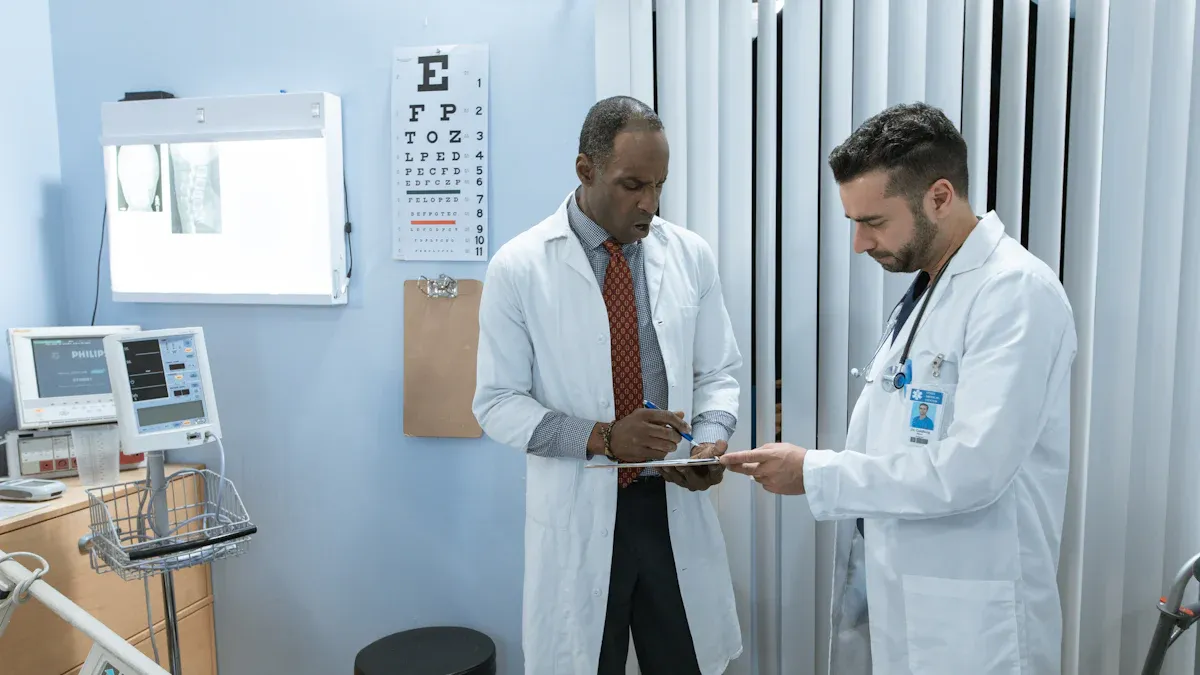What Is Cervical Cancer and How to Recognize Its Symptoms

Cervical cancer starts in the cervix, the part of your body connecting the uterus to the vagina. It is the fourth most common cancer in women worldwide, with approximately 660,000 new cases reported in 2022. Tragically, about 350,000 women die from it each year, with 94% of these deaths occurring in low- and middle-income countries. The highest rates are seen in sub-Saharan Africa, Central America, and South-East Asia. Early detection can save lives, so recognizing symptoms and seeking timely medical advice is crucial.
Did you know? In Eswatini, cervical cancer affects 96 out of every 100,000 women, the highest rate globally.
Key Takeaways
Cervical cancer is the fourth most common cancer in women. Regular check-ups can help find it early and save lives.
Watch for signs like unusual bleeding, strange discharge, or pain during sex. See a doctor right away if you notice these symptoms.
Get the HPV vaccine to lower your risk of cervical cancer. It works best if given before someone becomes sexually active.
Women aged 21 to 29 should get a Pap test every three years. Women aged 30 to 65 can choose a Pap test every three years or an HPV test every five years.
Use protection during sex and live a healthy life to lower your risk. Regular doctor visits can keep you healthy.
What Is Cervical Cancer?

Definition and Overview
Cervical cancer begins in the cells lining the cervix, the part of your body that connects the uterus to the vagina. Two types of cells exist in this area: glandular cells in the endocervix and squamous cells in the exocervix. Most cervical cancers start in the transformation zone, where these two cell types meet. This cancer develops gradually, often beginning as abnormal changes in the cells, known as cervical intraepithelial neoplasia (CIN). Unlike other cancers, this slow progression makes early detection possible and highly effective in preventing advanced disease.
How It Develops
Cervical cancer progresses through distinct stages. Initially, cancer cells grow from the surface of the cervix into deeper tissues. At Stage 1, the disease remains localized to the cervix. In Stage 1A, the cancer is microscopic, while in Stage 1B, it grows deeper than 5 millimeters. As it advances to Stage 2, the cancer spreads beyond the cervix and uterus but does not reach the pelvic or vaginal walls. Early stages often show no symptoms, making regular screenings essential for catching the disease before it spreads.
Why It’s Important to Understand
Understanding cervical cancer helps you recognize its risks and symptoms early. This knowledge empowers you to take preventive measures, such as regular screenings and vaccinations. Early detection significantly improves treatment outcomes. Without awareness, the disease may progress unnoticed, leading to more severe health complications. By learning about cervical cancer, you can protect yourself and encourage others to prioritize their health.
Symptoms of Cervical Cancer

Early Symptoms
Abnormal vaginal bleeding
One of the earliest signs of cervical cancer is abnormal vaginal bleeding. You might notice bleeding between your menstrual periods, after sexual intercourse, or even after menopause. This type of bleeding is not normal and should prompt you to consult a healthcare provider. Heavier or longer menstrual periods than usual can also indicate a problem. Paying attention to these changes can help you catch potential issues early.
Unusual vaginal discharge
Cervical cancer can cause unusual vaginal discharge. This discharge may appear thick, have a strong odor, or contain blood. These changes often go unnoticed, but staying alert to any differences in your discharge can make a significant difference in early detection.
Pain during intercourse
Experiencing pain during sexual intercourse is another early symptom of cervical cancer. This discomfort may result from changes in the cervix caused by abnormal cell growth. If you feel persistent pain during intimacy, it’s essential to seek medical advice.
Advanced Symptoms
Pelvic pain
As cervical cancer progresses, you may experience pelvic pain. This pain can range from mild discomfort to severe, persistent aches. It often occurs in the lower abdomen or back and may worsen over time. Pelvic pain should never be ignored, especially if it disrupts your daily activities.
Difficulty urinating or bowel changes
Advanced cervical cancer can affect nearby organs, leading to difficulty urinating or changes in bowel habits. You might feel pain or notice blood in your urine. Some individuals also experience diarrhea or rectal bleeding. These symptoms can significantly impact your quality of life and require immediate medical attention.
Swelling in the legs or unexplained weight loss
Swelling in one or both legs can occur when cervical cancer spreads to lymph nodes or blocks blood flow. This swelling is often accompanied by a dull ache or heaviness. Unexplained weight loss and fatigue are also common in advanced stages. These symptoms indicate that the body is struggling and should not be overlooked.
Note: Recognizing these symptoms early can improve your chances of successful treatment. If you notice any of these signs, consult a healthcare professional promptly.
Early Detection of Cervical Cancer
Importance of Early Detection
Detecting cervical cancer early can save lives. When caught in its initial stages, the five-year survival rate is as high as 91%. However, this rate drops significantly as the disease progresses. For example, if the cancer spreads to nearby tissues, the survival rate falls to 60%. Once it reaches distant organs, the rate decreases to just 19%.
Stage of Cervical Cancer | Five-Year Relative Survival Rate |
|---|---|
Not spread | 91% |
Spread to nearby tissues | 60% |
Spread to lymph nodes and distant organs | 19% |
Early detection allows for timely treatment, improving your chances of recovery. Regular screenings play a crucial role in identifying abnormal changes before they develop into cancer. By prioritizing early detection, you take control of your health and reduce the risk of severe complications.
Screening Methods
Pap smear
The Pap smear is one of the most effective tools for detecting cervical cancer. During this test, a healthcare provider collects cells from your cervix to check for abnormalities. This method identifies precancerous changes, allowing for early intervention. Regular Pap smears have significantly reduced cervical cancer deaths worldwide.
HPV testing
HPV testing focuses on detecting high-risk strains of the human papillomavirus (HPV), which cause most cervical cancers. This test identifies the virus before it leads to abnormal cell changes. It is highly sensitive and effective, especially when combined with a Pap smear. For women aged 30 to 65, HPV testing every five years is a recommended option.
Screening Method | Recommended Frequency | Age Group |
|---|---|---|
Cytology (Pap smear) | Every 3 years | 21-29 years |
Cytology or hrHPV testing | Every 3-5 years | 30-65 years |
Recommended Screening Frequency
Screening guidelines depend on your age and medical history:
Women aged 21 to 29 should undergo a Pap smear every three years.
Women aged 30 to 65 can choose between a Pap smear every three years, HPV testing every five years, or both tests together every five years.
Women younger than 21 or older than 65 with no risk factors do not need regular screenings.
If you’ve had a hysterectomy with cervix removal and no history of cervical cancer, screenings are unnecessary.
Regular screenings are essential for early detection. Following these guidelines ensures you stay proactive about your health.
Causes and Risk Factors of Cervical Cancer
Common Causes
Cervical cancer primarily develops due to long-lasting infections with high-risk types of human papillomavirus (HPV). Persistent HPV infections, especially with types 16 and 18, account for about 70% of cervical cancer cases worldwide. These high-risk HPV types can cause changes in cervical cells, leading to precancerous lesions. If these lesions go undetected and untreated, they may progress to cancer.
It’s important to note that most women with HPV do not develop cervical cancer. This indicates that additional factors, such as lifestyle choices and overall health, also contribute to the disease. Understanding these causes helps you take preventive measures, such as getting vaccinated against HPV and attending regular screenings.
Risk Factors
Persistent HPV infection
A persistent infection with the same high-risk HPV type significantly increases your risk of cervical cancer. For instance, HPV 16 alone carries a cumulative risk of 13.5% for cervical cancer. Regular screenings and HPV vaccinations can help reduce this risk.
HPV Type | Cumulative Risk of Cervical Cancer (%) |
|---|---|
HPV16 | 13.5 |
HPV58 | 10.3 |
Other | 4.0 |
HPV-negative | 0.26 |
Smoking
Smoking doubles your risk of cervical cancer. Tobacco byproducts can damage cervical cells, making them more vulnerable to HPV infections. Quitting smoking not only improves your overall health but also reduces your cancer risk.
Weakened immune system
A weakened immune system, often caused by conditions like HIV or certain medications, makes it harder for your body to fight off HPV infections. Regular health check-ups and treatments for underlying conditions can help strengthen your immunity.
Long-term use of birth control pills
Using oral contraceptives for more than five years slightly increases your risk of cervical cancer. Discussing the risks and benefits of long-term contraceptive use with your healthcare provider can help you make informed decisions.
Tip: Adopting a healthy lifestyle and staying proactive with screenings can significantly lower your risk of cervical cancer.
Prevention and Next Steps
Preventive Measures
HPV vaccination
The HPV vaccine is one of the most effective tools for preventing cervical cancer. It protects against the high-risk HPV types responsible for most cases. Gardasil 9, a widely used vaccine, is approved for individuals aged 9 to 45. Experts recommend vaccination for preteens aged 11 to 12, but it can start as early as age 9. If you missed the vaccine during childhood, you can still receive it up to age 26. Adults aged 27 to 45 may also benefit, but you should consult your doctor to evaluate the risks and benefits. The vaccine works best when given before sexual activity begins, as it prevents HPV infections rather than treating existing ones.
Aspect | Details |
|---|---|
Effectiveness | Protects against HPV types causing cervical cancer. |
Recommended Age for Vaccination | |
Catch-up Vaccination | Recommended for individuals up to age 26 who were not vaccinated earlier. |
Adults 27-45 | May consider vaccination after consulting a doctor about risks. |
Regular screenings
Routine screenings are essential for detecting cervical cancer early. Pap smears and HPV tests identify abnormal cell changes before they develop into cancer. Women aged 21 to 29 should have a Pap smear every three years. For women aged 30 to 65, combining a Pap smear with HPV testing every five years is an excellent option. Staying consistent with these screenings ensures that any potential issues are caught early, improving treatment outcomes.
Practicing safe sex
Practicing safe sex reduces your risk of HPV infection. Using condoms during sexual activity lowers the chances of transmission, although they do not provide complete protection. Limiting the number of sexual partners and avoiding smoking further decreases your risk. These simple steps can make a significant difference in preventing cervical cancer.
Tip: Discuss the HPV vaccine with your healthcare provider, schedule regular screenings, and adopt safe sex practices to protect yourself from cervical cancer.
When to Consult a Doctor
You should consult a doctor if you notice any unusual symptoms. Abnormal vaginal bleeding, such as bleeding after sex, between periods, or after menopause, requires immediate attention. Other warning signs include pelvic pain, changes in bowel habits, heavy menstrual periods, or unusual vaginal discharge. These symptoms may indicate cervical cancer or other health issues. Early medical intervention can lead to better outcomes, so don’t hesitate to seek advice if you experience any of these signs.
Reminder: Paying attention to your body and acting promptly on symptoms can save your life. Always prioritize your health by consulting a healthcare professional when needed.
Cervical cancer is a serious but preventable disease. You can take steps to protect yourself by staying informed and proactive.
Key actions to prevent and detect cervical cancer early:
Schedule regular Pap and HPV tests.
Get vaccinated against HPV.
Learn to recognize symptoms like abnormal bleeding or pelvic pain.
The HPV vaccine is a proven, safe, and effective way to prevent cervical cancer. Early detection through screenings saves lives.
If you notice unusual symptoms, consult your healthcare provider without delay.
FAQ
What is the main cause of cervical cancer?
Persistent infection with high-risk HPV types, such as HPV 16 and 18, causes most cervical cancer cases. These viruses can lead to abnormal cell changes in the cervix. Regular screenings and HPV vaccination help reduce your risk.
Can cervical cancer be prevented?
Yes, you can prevent cervical cancer by getting the HPV vaccine, attending regular screenings, and practicing safe sex. These steps lower your risk of HPV infection and help detect abnormal changes early.
Who should get the HPV vaccine?
The HPV vaccine is recommended for preteens aged 11-12 but can be given as early as age 9. If you missed it, you can still get vaccinated up to age 26. Adults aged 27-45 should consult their doctor.
How do I know if I need a Pap smear?
If you’re between 21 and 65 years old, you should schedule regular Pap smears. Women aged 21-29 need one every three years. For women aged 30-65, combining a Pap smear with HPV testing every five years is an option.
What should I do if I notice symptoms of cervical cancer?
If you experience abnormal bleeding, unusual discharge, or pelvic pain, consult a healthcare provider immediately. Early medical attention improves your chances of successful treatment and recovery.
Tip: Don’t ignore unusual symptoms. Early action can save your life.
---
ℹ️ Explore more: Read our Comprehensive Guide to All Known Cancer Types for symptoms, causes, and treatments.
See Also
Identifying Angioimmunoblastic T-Cell Lymphoma Symptoms and Characteristics
Exploring Anal Cancer Symptoms and Their Underlying Causes
Acute Lymphoblastic Leukemia: Key Symptoms and Overview
Essential Information on Symptoms of Adrenocortical Carcinoma
